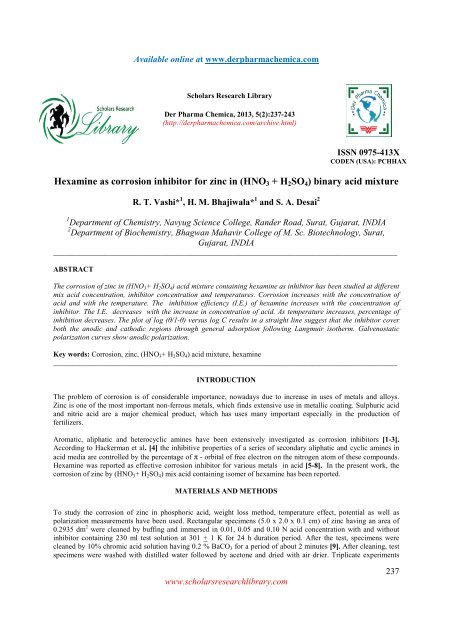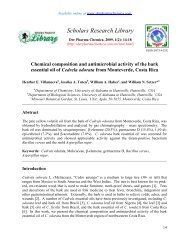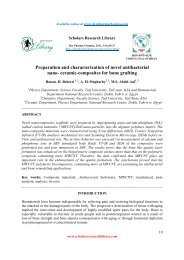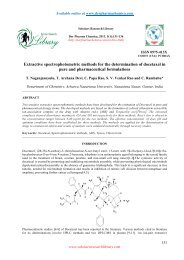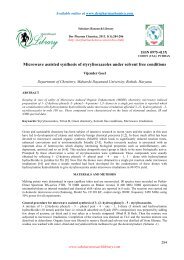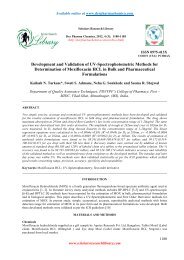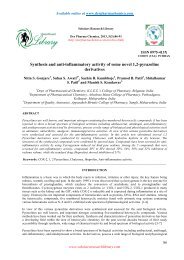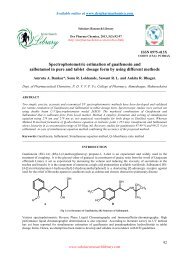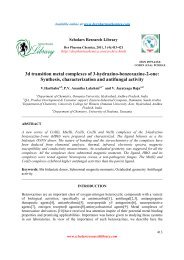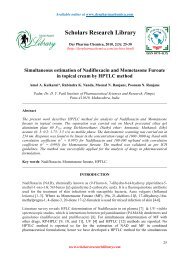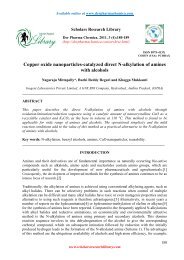Hexamine as corrosion inhibitor for zinc in (HNO3 + H2SO4) binary ...
Hexamine as corrosion inhibitor for zinc in (HNO3 + H2SO4) binary ...
Hexamine as corrosion inhibitor for zinc in (HNO3 + H2SO4) binary ...
You also want an ePaper? Increase the reach of your titles
YUMPU automatically turns print PDFs into web optimized ePapers that Google loves.
Available onl<strong>in</strong>e at www.derpharmachemica.com<br />
Scholars Research Library<br />
Der Pharma Chemica, 2013, 5(2):237-243<br />
(http://derpharmachemica.com/archive.html)<br />
ISSN 0975-413X<br />
CODEN (USA): PCHHAX<br />
<strong>Hexam<strong>in</strong>e</strong> <strong>as</strong> <strong>corrosion</strong> <strong><strong>in</strong>hibitor</strong> <strong>for</strong> <strong>z<strong>in</strong>c</strong> <strong>in</strong> (HNO 3 + H 2 SO 4 ) b<strong>in</strong>ary acid mixture<br />
R. T. V<strong>as</strong>hi* 1 , H. M. Bhajiwala* 1 and S. A. Desai 2<br />
1 Department of Chemistry, Navyug Science College, Rander Road, Surat, Gujarat, INDIA<br />
2 Department of Biochemistry, Bhagwan Mahavir College of M. Sc. Biotechnology, Surat,<br />
Gujarat, INDIA<br />
_____________________________________________________________________________________________<br />
ABSTRACT<br />
The <strong>corrosion</strong> of <strong>z<strong>in</strong>c</strong> <strong>in</strong> (HNO 3 + H 2 SO 4 ) acid mixture conta<strong>in</strong><strong>in</strong>g hexam<strong>in</strong>e <strong>as</strong> <strong><strong>in</strong>hibitor</strong> h<strong>as</strong> been studied at different<br />
mix acid concentration, <strong><strong>in</strong>hibitor</strong> concentration and temperatures. Corrosion <strong>in</strong>cre<strong>as</strong>es with the concentration of<br />
acid and with the temperature. The <strong>in</strong>hibition efficiency (I.E.) of hexam<strong>in</strong>e <strong>in</strong>cre<strong>as</strong>es with the concentration of<br />
<strong><strong>in</strong>hibitor</strong>. The I.E. decre<strong>as</strong>es with the <strong>in</strong>cre<strong>as</strong>e <strong>in</strong> concentration of acid. As temperature <strong>in</strong>cre<strong>as</strong>es, percentage of<br />
<strong>in</strong>hibition decre<strong>as</strong>es. The plot of log (θ/1-θ) versus log C results <strong>in</strong> a straight l<strong>in</strong>e suggest that the <strong><strong>in</strong>hibitor</strong> cover<br />
both the anodic and cathodic regions through general adsorption follow<strong>in</strong>g Langmuir isotherm. Galvenostatic<br />
polarization curves show anodic polarization.<br />
Key words: Corrosion, <strong>z<strong>in</strong>c</strong>, (HNO 3 + H 2 SO 4 ) acid mixture, hexam<strong>in</strong>e<br />
_____________________________________________________________________________________________<br />
INTRODUCTION<br />
The problem of <strong>corrosion</strong> is of considerable importance, nowadays due to <strong>in</strong>cre<strong>as</strong>e <strong>in</strong> uses of metals and alloys.<br />
Z<strong>in</strong>c is one of the most important non-ferrous metals, which f<strong>in</strong>ds extensive use <strong>in</strong> metallic coat<strong>in</strong>g. Sulphuric acid<br />
and nitric acid are a major chemical product, which h<strong>as</strong> uses many important especially <strong>in</strong> the production of<br />
fertilizers.<br />
Aromatic, aliphatic and heterocyclic am<strong>in</strong>es have been extensively <strong>in</strong>vestigated <strong>as</strong> <strong>corrosion</strong> <strong><strong>in</strong>hibitor</strong>s [1-3].<br />
Accord<strong>in</strong>g to Hackerman et al. [4] the <strong>in</strong>hibitive properties of a series of secondary aliphatic and cyclic am<strong>in</strong>es <strong>in</strong><br />
acid media are controlled by the percentage of π - orbital of free electron on the nitrogen atom of these compounds.<br />
<strong>Hexam<strong>in</strong>e</strong> w<strong>as</strong> reported <strong>as</strong> effective <strong>corrosion</strong> <strong><strong>in</strong>hibitor</strong> <strong>for</strong> various metals <strong>in</strong> acid [5-8]. In the present work, the<br />
<strong>corrosion</strong> of <strong>z<strong>in</strong>c</strong> by (HNO 3 + H 2 SO 4 ) mix acid conta<strong>in</strong><strong>in</strong>g isomer of hexam<strong>in</strong>e h<strong>as</strong> been reported.<br />
MATERIALS AND METHODS<br />
To study the <strong>corrosion</strong> of <strong>z<strong>in</strong>c</strong> <strong>in</strong> phosphoric acid, weight loss method, temperature effect, potential <strong>as</strong> well <strong>as</strong><br />
polarization me<strong>as</strong>urements have been used. Rectangular specimens (5.0 x 2.0 x 0.1 cm) of <strong>z<strong>in</strong>c</strong> hav<strong>in</strong>g an area of<br />
0.2935 dm 2 were cleaned by buff<strong>in</strong>g and immersed <strong>in</strong> 0.01, 0.05 and 0.10 N acid concentration with and without<br />
<strong><strong>in</strong>hibitor</strong> conta<strong>in</strong><strong>in</strong>g 230 ml test solution at 301 + 1 K <strong>for</strong> 24 h duration period. After the test, specimens were<br />
cleaned by 10% chromic acid solution hav<strong>in</strong>g 0.2 % BaCO 3 <strong>for</strong> a period of about 2 m<strong>in</strong>utes [9]. After clean<strong>in</strong>g, test<br />
specimens were w<strong>as</strong>hed with distilled water followed by acetone and dried with air drier. Triplicate experiments<br />
www.scholarsresearchlibrary.com<br />
237
R. T. V<strong>as</strong>hi et al Der Pharma Chemica, 2013, 5 (2):237-243<br />
_____________________________________________________________________________<br />
were per<strong>for</strong>med <strong>in</strong> each c<strong>as</strong>e and the mean value of weight loss w<strong>as</strong> reported <strong>in</strong> <strong>for</strong>m of <strong>corrosion</strong> rate. All chemicals<br />
used were of AR grade. The test solution w<strong>as</strong> prepared <strong>in</strong> double distilled water.<br />
For polarization study, metal specimens hav<strong>in</strong>g an area of 0.047 dm 2 were immersed <strong>in</strong> 230 ml corrosive solution<br />
without and with 1.0% <strong><strong>in</strong>hibitor</strong> concentration <strong>in</strong> b<strong>in</strong>ary acid mixture (0.01 N HNO 3 + 0.01 N H 2 SO 4 ). The test cell<br />
<strong>in</strong>cludes the metal specimen <strong>as</strong> a work<strong>in</strong>g electrode, corrosive solution <strong>in</strong> which the specimen w<strong>as</strong> to be tested and<br />
saturated calomel electrode (SCE) <strong>as</strong> a reference electrode <strong>as</strong> well <strong>as</strong> Plat<strong>in</strong>um electrode <strong>as</strong> an auxiliary electrode.<br />
The polarization study w<strong>as</strong> made by us<strong>in</strong>g Potentio-Galvano-Scan (Weav<strong>in</strong>g PGS 81) meter. Polarization curves<br />
were plotted with potential aga<strong>in</strong>st log current density (called Tafel plots). Tafel l<strong>in</strong>es correspond<strong>in</strong>gly. The <strong>in</strong>tersect<br />
po<strong>in</strong>t of cathodic and anodic Tafel l<strong>in</strong>es gives the <strong>corrosion</strong> current (Icorr) and the <strong>corrosion</strong> potential (E corr ) [10].<br />
RESULTS AND DISCUSSION<br />
The results are presented <strong>in</strong> Tables 1 to 3 and Figs. 1 to 3. To <strong>as</strong>sess the effect of <strong>corrosion</strong> of <strong>z<strong>in</strong>c</strong> <strong>in</strong> phosphoric<br />
acid, hexam<strong>in</strong>e is added <strong>as</strong> an <strong><strong>in</strong>hibitor</strong>.<br />
I.E. h<strong>as</strong> been calculated <strong>as</strong> follows:<br />
I.E. (%) = {(Wu – Wi) / Wu} × 100 ------------- (1)<br />
Where, W u is the weight loss of metal <strong>in</strong> un<strong>in</strong>hibited acid and<br />
W i is the weight loss of metal <strong>in</strong> <strong>in</strong>hibited acid.<br />
Energy of activation (Ea) h<strong>as</strong> been calculated from the slope of log ρ versus 1/T (ρ = <strong>corrosion</strong> rate, T = absolute<br />
temperature) (Fig. 2) and also with the help of the Arrhenius equation [11].<br />
ρ<br />
2<br />
Ea<br />
log = [ (1 / T1<br />
) − (1 / T<br />
2<br />
) ]<br />
− − − − − (2)<br />
ρ 2.303 R<br />
1<br />
where, ρ 1 and ρ 2 are the <strong>corrosion</strong> rate at temperature T 1 and T 2 respectively.<br />
The value of heat of adsorption (Q ads ) were calculated by the follow<strong>in</strong>g equation [11].<br />
Q ads = 2.303 R [log ( θ 2 / 1 – θ 2 ) - log ( θ 1 / 1 – θ 1 )] x [T 1 . T 2 / T 2 – T 1 ] --(3)<br />
where, θ 1 and θ 2 [θ = (Wu – Wi)/Wi] are the fractions of the metal surface covered by the <strong><strong>in</strong>hibitor</strong>s at temperature<br />
T 1 and T 2 respectively.<br />
The values of the free energy of adsorption (∆Ga) were calculated with the help of the follow<strong>in</strong>g equation [12].<br />
log C = log ( θ / 1 – θ ) – log B ---------(4)<br />
Where, log B = –1.74 – (∆Ga / 2.303 RT) and C is the <strong><strong>in</strong>hibitor</strong> concentration.<br />
The enthalpy of adsorption (∆H º a) and entropy of adsorption (∆S º a) are calculated us<strong>in</strong>g the equation.<br />
∆H º a = E a – RT ---------(5)<br />
∆S º a = ∆H – ∆G /T ---------(6)<br />
Corrosion <strong>in</strong> acid: The rate of <strong>corrosion</strong> <strong>in</strong>cre<strong>as</strong>es with the <strong>in</strong>cre<strong>as</strong>e <strong>in</strong> acid concentration. The <strong>corrosion</strong> rate w<strong>as</strong><br />
213.7, 975.2 and 1921.4 mg/dm 2 <strong>in</strong> 0.01, 0.05 and 0.1 N (HNO 3 + H 2 SO 4 ) mixed acid concentrations respectively <strong>for</strong><br />
a period of 24 h at 301 + 1 K <strong>as</strong> shown <strong>in</strong> Table-1.<br />
www.scholarsresearchlibrary.com<br />
238
R. T. V<strong>as</strong>hi et al Der Pharma Chemica, 2013, 5 (2):237-243<br />
_____________________________________________________________________________<br />
Effect of <strong><strong>in</strong>hibitor</strong> concentration: The I.E. of the hexam<strong>in</strong>e <strong>in</strong>cre<strong>as</strong>es with the <strong><strong>in</strong>hibitor</strong> concentration, e.g. <strong>in</strong> c<strong>as</strong>e<br />
of hexam<strong>in</strong>e <strong>in</strong> 0.10 N HNO 3 + 0.10 N H 2 SO 4 acid mixture the I.E. w<strong>as</strong> found to be 32.1, 50.5 and 59.8 % with<br />
respect to 0.1, 0.5 and 1.0 % <strong><strong>in</strong>hibitor</strong> concentration respectively [Table- 1].<br />
Effect of acid concentration: The I.E. decre<strong>as</strong>es with the <strong>in</strong>cre<strong>as</strong>e <strong>in</strong> acid concentration. At 1.0 % <strong><strong>in</strong>hibitor</strong><br />
concentration, the I.E. of hexam<strong>in</strong>e w<strong>as</strong> 33.2, 49.9 and 59.8% with respect to 0.01, 0.05 and 0.10 N (HNO 3 +<br />
H 2 SO 4 ) mixed acid concentration respectively [Table -1].<br />
Table 1: Corrosion rate (CR) and <strong>in</strong>hibition efficiency (I.E.) of <strong>z<strong>in</strong>c</strong> <strong>in</strong> 0.01, 0.05 and 0.10 N (HNO 3 + H 2SO 4) acid conta<strong>in</strong><strong>in</strong>g hexam<strong>in</strong>e<br />
<strong>as</strong> <strong><strong>in</strong>hibitor</strong> <strong>for</strong> an immersion period of 24 h at 301 ± 1 K.<br />
Acid concentration<br />
Syatem<br />
Conc. of <strong><strong>in</strong>hibitor</strong> 0.01 N 0.05 N 0.10 N<br />
CR I.E. CR I.E. CR I.E.<br />
(%) mg/dm 2 % mg/dm 2 % mg/dm 2 %<br />
A - 213.7 - 975.2 - 1921.4 -<br />
B 0.1 171.0 20.0 684.9 29.8 1292.9 32.1<br />
0.5 154.7 27.6 551.7 43.4 951.3 50.5<br />
1.0 142.7 33.3 488.2 49.9 771.5 59.8<br />
A = (HNO 3 + H 2SO 4) B = <strong>Hexam<strong>in</strong>e</strong> + (HNO 3 + H 2SO 4)<br />
Effect of temperature: The effect of temperature on the <strong>corrosion</strong> of <strong>z<strong>in</strong>c</strong> is shown <strong>in</strong> Table- 2. In (0.05 N HNO 3 +<br />
0.05 N H 2 SO 4 ) mixed acid, <strong>corrosion</strong> rate <strong>in</strong>cre<strong>as</strong>es <strong>as</strong> temperature <strong>in</strong>cre<strong>as</strong>es i.e. <strong>corrosion</strong> rate w<strong>as</strong> 700.5, 783.2,<br />
832.0 and 895.2 mg/dm 2 <strong>for</strong> 3 h immersion period. Inhibition efficiency w<strong>as</strong> decre<strong>as</strong>e with temperature. The I.E. <strong>for</strong><br />
hexam<strong>in</strong>e at 1.0% concentration w<strong>as</strong> 80.9, 75.0, 68.8 and 61.4% at 303, 313, 323 and 333 K respectively <strong>for</strong> 3 h<br />
immersion period. .<br />
Value of ‘Ea’ calculated from eq.2 w<strong>as</strong> found to be higher (26.4 kJ mol -1 ) than that of un<strong>in</strong>hibited system (6.8 kJ<br />
mol -1 ). This suggests that the presence of reactive centres on the <strong><strong>in</strong>hibitor</strong> can block the active sites <strong>for</strong> <strong>corrosion</strong>,<br />
result<strong>in</strong>g <strong>in</strong> an <strong>in</strong>cre<strong>as</strong>e <strong>in</strong> ‘Ea’[13]. The values of Ea calculated from the slope of Arrhenius plot and us<strong>in</strong>g eq.2 are<br />
almost similar. It w<strong>as</strong> evident that <strong>in</strong> all c<strong>as</strong>es, the Q ads values were negative and rang<strong>in</strong>g from –25.9 to –29.1 kJ<br />
mol -1 . Oguzie [14] expla<strong>in</strong>ed that the negative values of Q ads also signify that the degree of surface coverage<br />
decre<strong>as</strong>ed with rise <strong>in</strong> temperature.<br />
Table 2: Effect of temperature on <strong>corrosion</strong> rate (CR), <strong>in</strong>hibitive efficiency (IE%), energy of activation (Ea) and heat of adsorption<br />
(Qads) <strong>for</strong> <strong>z<strong>in</strong>c</strong> <strong>in</strong> 0.05 N (HNO 3 + H 2SO 4) b<strong>in</strong>ary acid mixture conta<strong>in</strong><strong>in</strong>g <strong><strong>in</strong>hibitor</strong>.<br />
Inhibitor concentration = 1.0 %<br />
Immersion period = 3 h<br />
System<br />
Temperature, K<br />
303 313 323 333<br />
Mean<br />
Ea<br />
from<br />
eq.2<br />
Ea from<br />
Arrhenious<br />
CR I.E. CR I.E. CR I.E. CR I.E. Plot Q abs (kJ mol -1 ) ∆G a ∆H a ∆S a<br />
mg/dm 2 % mg/dm 2 % mg/dm 2 % mg/dm 2 %<br />
kJ<br />
mol -1<br />
kJ 303-<br />
mol -1 313<br />
A 700.5 - 783.2 - 832.0 - 895.2 - 6.8 7.65 - - - - - -<br />
- -<br />
-<br />
B 134.0 80.9 196.1 75.0 260.0 69.8 345.6 61.4 26.4 27.4<br />
-29.1 27.5 0.155<br />
27.2 25.9<br />
19.2<br />
A = (HNO 3 + H 2SO 4) B = <strong>Hexam<strong>in</strong>e</strong> + (HNO 3 + H 2SO 4)<br />
The mean ∆G a values w<strong>as</strong> (-19.2 kJ mol -1 ). This suggests that they are strongly adsorbed on the metal surface. This<br />
statement w<strong>as</strong> supported by the work of Talati and Darji [15]. The enthalpy changes (∆H a ) w<strong>as</strong> positive (27.5 kJ<br />
mol -1 ) <strong>in</strong>dicat<strong>in</strong>g the endothermic nature of the reaction [16] suggest<strong>in</strong>g that higher temperature favours the<br />
<strong>corrosion</strong> process. Adeyen [17] described that if the ∆H < 10 kJ mol -1 the adsorption is probably physisorption and if<br />
the ∆H > 10 kJ mol -1 values <strong>in</strong>dicate that the hexam<strong>in</strong>e strongly adsorbed on <strong>z<strong>in</strong>c</strong> is chemisorption. The entropy<br />
(∆S º a) values w<strong>as</strong> positive (0.155 kJ mol -1 ) confirm<strong>in</strong>g that the <strong>corrosion</strong> process is entropically favourable [18].<br />
Polarization behaviour: Anodic and cathodic galvenostatic polarization curves <strong>for</strong> Z<strong>in</strong>c <strong>in</strong> 0.01 N HNO 3 + 0.01 N<br />
H 2 SO 4 acid mixture, alone and conta<strong>in</strong><strong>in</strong>g 1.0 % concentration of hexam<strong>in</strong>e is shown <strong>in</strong> Fig. 3. The curves show<br />
313-<br />
323<br />
323-<br />
333<br />
kJ<br />
mol -1<br />
kJ<br />
mol -1<br />
kJ<br />
mol -<br />
1<br />
www.scholarsresearchlibrary.com<br />
239
R. T. V<strong>as</strong>hi et al Der Pharma Chemica, 2013, 5 (2):237-243<br />
_____________________________________________________________________________<br />
anodic polarization . I.E. calculated from <strong>corrosion</strong> current obta<strong>in</strong>ed by extrapolation of the cathodic and anodic<br />
Tafel l<strong>in</strong>es are given <strong>in</strong> Table-3. The I.E. calculated from Tafel plots agree well (with<strong>in</strong> ± 3%) with the values<br />
obta<strong>in</strong>ed from weight loss data.<br />
Table 3: Polarisation data and <strong>in</strong>hibition efficiency (I.E.) of hexam<strong>in</strong>e <strong>for</strong> <strong>z<strong>in</strong>c</strong> <strong>in</strong> (0.01 N HNO 3 + 0.01 N H 2SO 4) b<strong>in</strong>ary acid mixture at<br />
301 ± 1 K.<br />
Inhibitor concentration: 1.0% Effective area of specimen = 0.047 dm 2<br />
System<br />
E corr CD Tafel slope (mV/decade) B I.E. (%) from methods<br />
(mV) Icorr (mA/cm 2 ) Anodic β a Cathodic -β c (mV) Weight loss By polarization<br />
A -1140 0.300 466 200 60.9 - -<br />
B -1075 0.210 365 238 62.7 33.2 30.0<br />
A = (HNO 3 + H 2SO 4) B = <strong>Hexam<strong>in</strong>e</strong> + (HNO 3 + H 2SO 4)<br />
β a = Anodic Tafel constant, β C = Cathodic Tafel constant. β =( β a x β c)/[2.3 (Β a + β c)]<br />
CD = Corrosion current density from <strong>in</strong>tersection of anodic and cathodic l<strong>in</strong>es.<br />
Mechanism of <strong>corrosion</strong>: Generally, <strong>z<strong>in</strong>c</strong> dissolve <strong>in</strong> phosphoric acid solution due to somewhat hydrogen type of<br />
attack, the reaction tak<strong>in</strong>g place at the microelectrodes of the <strong>corrosion</strong> cell be<strong>in</strong>g represented <strong>as</strong>,<br />
Zn -------> Zn +2 + 2e - (anodic reaction) --------(7)<br />
Reduction reaction is <strong>in</strong>dicated by decre<strong>as</strong>e <strong>in</strong> valence or the consumption of electrodes, <strong>as</strong> shown by the follow<strong>in</strong>g<br />
equation.<br />
2H + + 2e - -------> 2H (ads.) (cathodic reaction) --------(8)<br />
or H + H 3 O + + e - -------> H 2 ↑ + H 2 O --------(9)<br />
The mechanism of <strong><strong>in</strong>hibitor</strong> of <strong>corrosion</strong> is believed to be due to the <strong>for</strong>mation and ma<strong>in</strong>tenance of a protective film<br />
on the metal surface. Further, when log (θ /1-θ) is plotted aga<strong>in</strong>st log C straight l<strong>in</strong>es were obta<strong>in</strong>ed <strong>in</strong> the c<strong>as</strong>e of<br />
hexam<strong>in</strong>e studied (Fig. 1). This suggests that the <strong><strong>in</strong>hibitor</strong> cover both the anodic <strong>as</strong> well <strong>as</strong> cathodic regions through<br />
general adsorption follow<strong>in</strong>g Langmuir adsorption isotherm.<br />
N<br />
H 2 C<br />
CH 2<br />
CH 2<br />
N<br />
N<br />
CH 2<br />
H 2 C<br />
N<br />
CH 2<br />
Structure of <strong>Hexam<strong>in</strong>e</strong><br />
Macro molecular size and higher number of N-atoms of hexam<strong>in</strong>e [19] might have covered almost all active source<br />
of <strong>z<strong>in</strong>c</strong> Four nitrogen atom of the hexam<strong>in</strong>e hav<strong>in</strong>g high electron density must have functioned <strong>as</strong> the reaction centre<br />
[20] and the hexam<strong>in</strong>e molecules might have been chemisorbed to <strong>for</strong>m a th<strong>in</strong> monolayer on the <strong>z<strong>in</strong>c</strong> surface.<br />
<strong>Hexam<strong>in</strong>e</strong> (hexamethylenetetram<strong>in</strong>e) consists of four nitrogen atoms and six CH 2 groups. Because of the presence of<br />
three nitrogen atoms electrons are disposed e<strong>as</strong>ily <strong>in</strong> the r<strong>in</strong>g and there<strong>for</strong>e it is expected to be an effective <strong><strong>in</strong>hibitor</strong>.<br />
The <strong><strong>in</strong>hibitor</strong> action can be accounted by the <strong>in</strong>teraction of lone pair of electrons <strong>in</strong> the nitrogen atom on the<br />
positively charged metal surface. The presence of six methylene groups also helps to lead to an enhancement of<br />
electron density at the nitrogen atom, which enhances its adsorption on the metal surface. This <strong>in</strong> turn leads to an<br />
<strong>in</strong>cre<strong>as</strong>e <strong>in</strong> the value of I.E. [21].<br />
www.scholarsresearchlibrary.com<br />
240
R. T. V<strong>as</strong>hi et al Der Pharma Chemica, 2013, 5 (2):237-243<br />
_____________________________________________________________________________<br />
In c<strong>as</strong>e of hexam<strong>in</strong>e cathodic polarization w<strong>as</strong> greater than anodic polarization. There<strong>for</strong>e, it is reveled that<br />
hexam<strong>in</strong>e is a cathodic <strong><strong>in</strong>hibitor</strong> and controls cathodic <strong>corrosion</strong> process. The protective effect of the <strong><strong>in</strong>hibitor</strong> is<br />
probably due to <strong>for</strong>mation of an <strong>in</strong>soluble film [22] Hence, the mechanism of the <strong>in</strong>hibitive action is possibly due to<br />
the block<strong>in</strong>g of cathodic sites by adsorption, which enables the <strong>for</strong>mation of a protective <strong>in</strong>soluble film.<br />
Fig.1 : Plot of (θ / 1- θ ) versus C <strong>for</strong> hexam<strong>in</strong>e <strong>in</strong> (0.05 N HNO 3+ 0.05 N H 2SO 4) mix acid concentration.<br />
Fig. 2 : Arrhenius plots <strong>for</strong> <strong>corrosion</strong> of Z<strong>in</strong>c <strong>in</strong> (0.05 N HNO 3 + 0.05 N H 2SO 4) mix acid <strong>in</strong> presence of 1.0 % <strong><strong>in</strong>hibitor</strong> concentration.<br />
www.scholarsresearchlibrary.com<br />
241
R. T. V<strong>as</strong>hi et al Der Pharma Chemica, 2013, 5 (2):237-243<br />
_____________________________________________________________________________<br />
Fig. 3 : Polarisation curves <strong>for</strong> <strong>corrosion</strong> of <strong>z<strong>in</strong>c</strong> <strong>in</strong> (0.01 N HNO 3 + 0.01 N H 2SO 4)mix acid conta<strong>in</strong><strong>in</strong>g 1.0 % <strong><strong>in</strong>hibitor</strong> concentration.<br />
CONCLUSION<br />
* As the acid concentration <strong>in</strong>cre<strong>as</strong>e the <strong>corrosion</strong> rate <strong>in</strong>cre<strong>as</strong>es and I.E. of <strong><strong>in</strong>hibitor</strong> decre<strong>as</strong>es.<br />
* At all concentration of acid, <strong>as</strong> the <strong><strong>in</strong>hibitor</strong> concentration <strong>in</strong>cre<strong>as</strong>es I.E. <strong>in</strong>cre<strong>as</strong>es and <strong>corrosion</strong> rate decre<strong>as</strong>es.<br />
* Mean value of ‘Ea’ <strong>in</strong> <strong>in</strong>hibited acid are higher than the value of ‘Ea’ <strong>in</strong> acid only, which shows that<br />
chemisorptions of the <strong><strong>in</strong>hibitor</strong> molecule.<br />
* As the temperature <strong>in</strong>cre<strong>as</strong>es <strong>corrosion</strong> rate <strong>in</strong>cre<strong>as</strong>es while I. E. decre<strong>as</strong>es.<br />
Acknowledgement<br />
The authors are thankful to Department of Chemistry, Navyug Science College, Surat <strong>for</strong> provid<strong>in</strong>g laboratory<br />
facilities.<br />
REFERENCES<br />
[1] V. A. Champaneri and R. T. V<strong>as</strong>hi , Asian J. Chem., 2010, 22(3),1799-1807<br />
[2] R. T. V<strong>as</strong>hi , H. M. Bhajiwala and S. A. Desai , Oriental J. Chem.,2009, 33, 557<br />
[3] N. K. Patel, S. S. Sampat , J. C. Vora and R. M. Trivedi , Werkst and Korros., 1970, 10, 809.<br />
[4] N. Hackerman , Annali Uni. Ferrara NS Sez. Suppl., 1961, 3, 99.<br />
[5] R. T. V<strong>as</strong>hi and Diksha Naik , E-J Chem., 2010, 7(S1), S1-S6.<br />
[6] R. T. V<strong>as</strong>hi and Krunal Desai, Der Pharma Chemica., 2012, 4(5), 2117-2123.<br />
[7] M. N. Desai , G. H. Thanki and H. Mar<strong>in</strong>al<strong>in</strong>i , Anti-Corr. Methods Mater, 1988, 15.<br />
[8] G. N. Mehta , Bull. Electrochem.,1988, 4(2), 111.<br />
[9] E. G. Stroud, J. Appl. Chem., 1951, 1, 93.<br />
[10] H. H. Uhlig , Corr. and Corr. Cont., Wiley, USA, 1967, 18.<br />
[11] N. Subramanian and K. Ramakrishnaiah , Ind. J. Tech.,1970, 8 , 369.<br />
[12] A.M. S Abdel and A.E.L Saied , Trans SAEST, 1981,16 , 197.<br />
[13] Aal M.S. Abdel and M. S. Morad , Br. Corr. J., 2001, 36, 253.<br />
[14] E. E. Oguzie , Mater. Chem. Phys., 2004, 87, 212.<br />
[15] J. D. Talati and J. M. Darji , J. Indian Chem. Soc.,1988, Vol. LXV February 94 –99.<br />
[16] D. Agrawal et al., Trans. SAEST, 2003, 38, 111-114.<br />
[17] O. O. Adeyen , Bull. Electrochem., 2005, 21, 363.<br />
[18] R. M. IssaA.Z. , El-Sonbati , A. A. El-B<strong>in</strong>dary and H. M. Kera , Eur. Polym. J., 2002, 38, 561.<br />
[19] I. L. F<strong>in</strong>ar , “Organic Chemistry” Vol II, ELBS and Longman, 1959, 153.<br />
[20] R. C. Ayers and N. Hackerman , J. Electrochem. Soc., 1963, 110, 507.<br />
www.scholarsresearchlibrary.com<br />
242
R. T. V<strong>as</strong>hi et al Der Pharma Chemica, 2013, 5 (2):237-243<br />
_____________________________________________________________________________<br />
[21] V. Violet Dhayabaran , A. Rajendran , Vimala J Rosal<strong>in</strong>e and A. Anandhakumar , Trans. SAEST, 2005, 40,<br />
134-138.<br />
[22] N. S. Rawat and A. K. S<strong>in</strong>gh , Bull. Electrochem., 1987, 3, 7.<br />
www.scholarsresearchlibrary.com<br />
243


